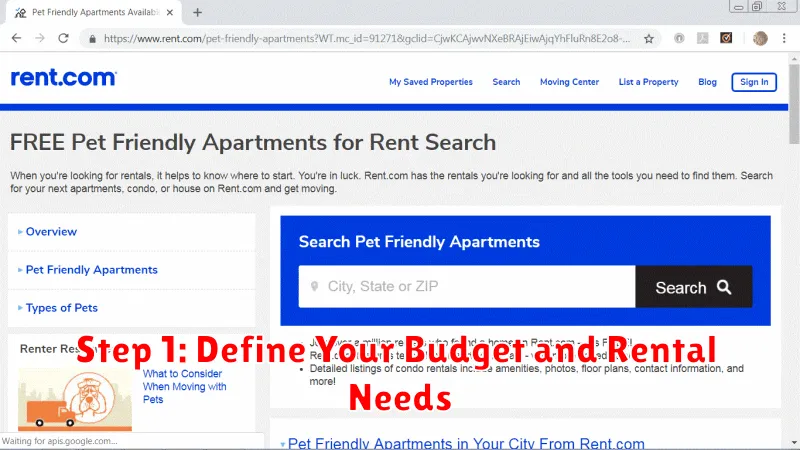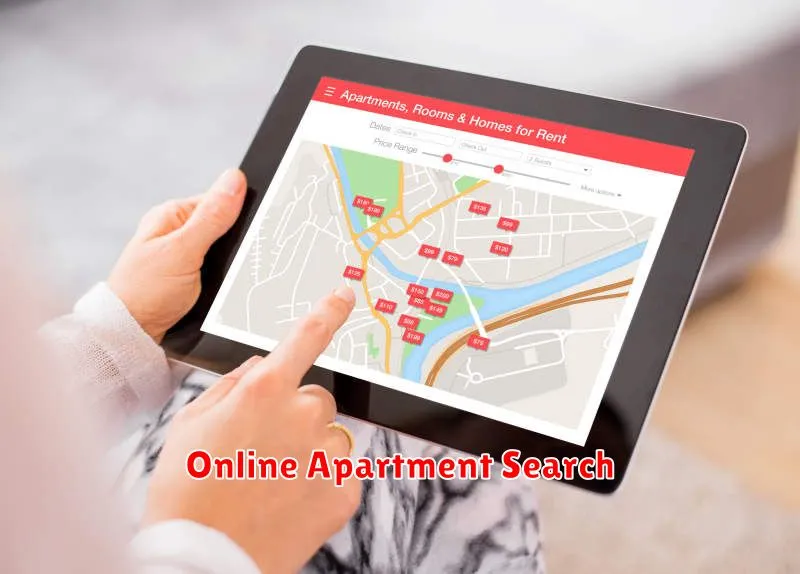Finding the perfect apartment rental can feel like searching for a needle in a haystack, but it doesn’t have to be! With the right approach and a little online savvy, you can streamline your search and find your dream apartment quickly and easily. This guide provides 10 steps to finding the perfect apartment rental online, covering everything from defining your needs and setting a budget to navigating online listings and securing your dream space. Learn how to leverage online apartment search tools, avoid common pitfalls, and ultimately, find the perfect place to call home. Let’s get started on your apartment hunting journey!
Introduction: The Convenience of Online Apartment Hunting
Finding a new apartment can be a stressful experience, but the rise of online apartment hunting has significantly eased the process. Gone are the days of driving around, endlessly searching for “For Rent” signs and dealing with potentially unreliable listings. Now, with a few clicks, you can access hundreds, even thousands, of apartment listings from the comfort of your own home.
This convenience extends beyond simply browsing. Online platforms offer detailed descriptions, high-quality photos, and often even virtual tours, allowing you to thoroughly investigate potential apartments without ever leaving your house. You can filter your search by price, location, amenities, and other crucial criteria, making the search much more efficient and targeted.
Furthermore, many online platforms allow you to directly contact landlords or property managers, schedule viewings, and even submit applications, all within the same online interface. This streamlined approach saves you valuable time and effort, letting you focus on finding the perfect apartment rather than getting bogged down in the logistical hurdles.
In short, online apartment hunting offers an unparalleled level of convenience and efficiency. This guide will explore ten key steps to leverage these online tools to find your ideal rental property.
Step 1: Define Your Budget and Rental Needs

Before you even start browsing online listings, it’s crucial to define your budget. Consider not only the rent itself but also utilities (electricity, water, gas, internet), security deposit, and any potential pet fees or parking costs. Be realistic – aim for a monthly rent that’s comfortably within your means, leaving room for unexpected expenses.
Next, clearly define your rental needs. Think about the size of apartment you require (number of bedrooms and bathrooms), location (proximity to work, schools, or public transportation), and amenities that are important to you (in-unit laundry, a balcony, a gym, etc.). Creating a detailed list will help you narrow your search and avoid wasting time on unsuitable properties.
Listing your priorities in order of importance can be incredibly helpful. For instance, if a short commute is non-negotiable, prioritize location over having a larger apartment. By being upfront about your needs and budget, you’ll be able to efficiently filter through online listings and focus on apartments that are truly a good fit for you.
Step 2: Choose Reliable Rental Platforms
Finding the perfect apartment starts with choosing the right platform. Don’t waste time on unreliable sites. Instead, focus on established and reputable rental platforms. These platforms often offer features like verified listings, tenant reviews, and robust search filters, making your search much more efficient and safe.
Consider using a mix of platforms to broaden your reach. National platforms like Zillow, Apartments.com, and Trulia offer vast listings, while regional or local sites may reveal hidden gems in your specific area. Check for features like background checks, secure payment options, and customer support before committing to any platform.
Remember, while convenience is key, security should be your priority. A reputable platform will take measures to protect both landlords and renters. Be wary of sites with unusually low prices or those lacking essential verification processes. By carefully choosing your rental platforms, you set yourself up for a smoother and safer apartment hunting experience.
Step 3: Filter Search Results for Location and Amenities
Once you’ve entered your search criteria, it’s time to refine your results. Most apartment search websites offer robust filtering options. This is where you’ll leverage location-based filters to narrow down your search to specific neighborhoods or zip codes. Consider factors like proximity to your workplace, schools, public transportation, and desired lifestyle.
Equally important are amenity filters. Think about what features are must-haves for you. Do you need parking? In-unit laundry? A gym? A pet-friendly building? A pool? Use the filters to select only apartments that offer these features, saving you time and effort from reviewing irrelevant listings.
Don’t be afraid to experiment with different combinations of location and amenity filters. You might find that slightly adjusting your location preferences opens up a wider array of apartments with your desired amenities. This iterative process allows you to gradually narrow your options to the most suitable choices.
Step 4: Check Photos and Virtual Tours
Once you’ve narrowed down your apartment options, it’s time to delve into the visuals. Photos and virtual tours are crucial for getting a feel for the space. Don’t just glance; truly examine them.
Look beyond the staged shots: While professional photos often make apartments look amazing, try to identify potential issues. Are there any signs of poor maintenance? Examine the walls, floors, and appliances closely. Does the lighting seem natural or artificially enhanced? Pay close attention to details that might be overlooked in a quick scan.
Virtual tours offer a more immersive experience: If available, take advantage of virtual tours. These allow you to explore the apartment at your own pace, noticing things you might miss in still photos. Pay attention to the flow of the space, the overall feel, and any unexpected features or flaws.
Don’t be afraid to be critical: Remember, these images are meant to attract you. Use your judgment. If something feels off or inconsistent with the description, it’s better to address your concerns with the landlord or property manager before proceeding.
By carefully reviewing photos and virtual tours, you can significantly reduce the risk of disappointment and ensure your online apartment search is as effective as possible. This step saves you time and potential hassle later on.
Step 5: Read Tenant Reviews and Ratings

Before committing to an apartment, thoroughly research tenant reviews and ratings. Websites like ApartmentRatings.com, Google Reviews, and Yelp offer valuable insights into the actual living experience at different properties. Look for patterns in reviews – are there recurring complaints about maintenance, noise levels, or management responsiveness?
Pay close attention to both positive and negative reviews. Positive reviews can highlight desirable aspects of the property, while negative reviews can reveal potential deal-breakers. Consider the number of reviews – a large volume of reviews provides a more reliable picture than a few isolated comments.
Don’t just focus on the star rating. Read the actual text of the reviews to understand the nuances of the tenant experience. Look for specific details about the apartment’s condition, the landlord’s responsiveness, and the overall living environment. This will give you a much clearer picture than a simple numerical score.
Remember that individual experiences can vary, but consistent themes across multiple reviews often indicate underlying issues with the property or management company. Using tenant reviews effectively allows you to make a more informed decision and avoid potential problems down the line.
Step 6: Verify Landlord Credentials and Listings
Once you’ve found a few promising apartment listings, it’s crucial to verify the landlord’s credentials and the accuracy of the listing. Don’t rely solely on online information; conduct thorough research.
First, search the landlord’s name online. Look for reviews, complaints, or any negative press. Sites like the Better Business Bureau (BBB) can be valuable resources. Check if they are a registered business and what their reputation is.
Next, verify the property address. Use online mapping tools to ensure the property exists and matches the description in the listing. Look at street view images to get a visual confirmation.
If possible, try contacting previous tenants. While this might be challenging, a quick search on social media or online forums could provide valuable insights. Ask about their experiences with the landlord and the property’s condition.
Finally, be wary of listings that seem too good to be true. Extremely low rents or unusually luxurious amenities compared to similar properties in the area should raise a red flag. It’s better to err on the side of caution and investigate further.
By taking these steps, you can significantly reduce the risk of encountering scams or dishonest landlords, protecting yourself and your investment.
Step 7: Ask Questions Before Scheduling a Visit
Before you schedule a visit, ask clarifying questions about the apartment and the rental process. This saves you time and ensures the property aligns with your needs. Don’t hesitate to be thorough!
Important questions to ask include: Are utilities included? What’s the application process like? What are the lease terms? Are pets allowed? Is parking available, and if so, what’s the cost? Are there any additional fees? Getting answers beforehand prevents unpleasant surprises later.
Consider asking about the neighborhood as well. What’s the area like? Is it safe? Are there nearby amenities you’ll need, such as grocery stores or public transportation?
By asking these preemptive questions, you can significantly improve your chances of finding the perfect apartment and avoid wasting time viewing unsuitable properties. Remember, a well-informed decision is a good decision.
Step 8: Compare Rental Agreements and Costs
Once you’ve shortlisted a few apartments, it’s time to carefully examine the rental agreements and associated costs. Don’t rush this crucial step!
Compare the lease terms: Pay close attention to the lease length, renewal options, and any clauses regarding early termination. Look for hidden fees or restrictions.
Analyze the rental costs: Beyond the advertised rent, consider all associated fees. This includes security deposits, pet fees (if applicable), application fees, parking fees, and utilities (whether included in rent or paid separately). Calculate the total monthly cost to get a complete picture.
Consider the location: While comparing costs, factor in the location’s proximity to your work, amenities, and transportation. A slightly higher rent might be worth it for a more convenient location, saving you time and money in the long run.
Don’t hesitate to ask questions: If anything is unclear in the rental agreement or about the costs, don’t hesitate to contact the landlord or property manager for clarification. A thorough understanding is essential before signing.
By meticulously comparing rental agreements and costs, you can ensure you’re making the most financially sound and suitable decision for your needs.
Conclusion: Making the Most of Online Apartment Searches
Finding the perfect apartment online requires strategy and diligence. By following the ten steps outlined in this guide, you’ve armed yourself with the tools to navigate the online rental market effectively. Remember to be patient, organized, and thorough in your search. Don’t rush the process; take your time to carefully consider your options and thoroughly vet potential landlords and properties.
Utilize advanced search filters, read reviews carefully, and ask plenty of questions before committing to anything. With a proactive and informed approach, you can significantly increase your chances of finding an apartment that perfectly suits your needs and budget. Happy apartment hunting!

